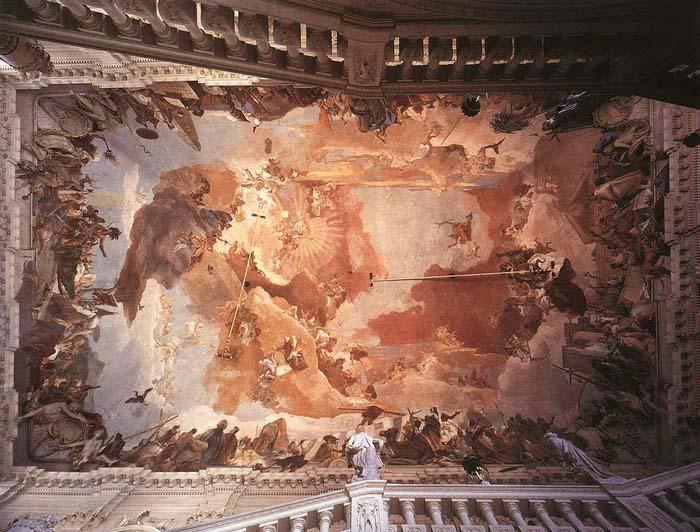New Crafts LLC
Las Reproducciones del Oleo de Europa España Dirigen
Pintura Identificación:: 63761
Giovanni Battista Tiepolo
Apollo and the Continents
1752-53 Fresco, 1900 x 3050 cm Stairwell of the Residenz, W?rzburg The picture shows an overall view of the ceiling, photographed from below. The perspectival distortion at the edges of the overall view of the ceiling fresco tell us that this was never intended as a vantage point for the visitor. Instead, the fresco was to open out to the viewer as he ascended the staircase. Apollo is portrayed in the centre of the heavens, Venus and Mars rest on a cloud below him, while the zodiac appears on a band behind them with the four seasons to the left. The Horae can be recognized by their butterfly wings. The upper part of the fresco is meant to be viewed from the opposite angle and shows Mercury and, a little below him, the gods Diana, Jupiter and Saturn. The composition of the ceiling fresco takes into account the many viewpoints available to the visitor, who changes direction several times during his climb up the stairs, and who cannot take in the whole fresco at a glance. Tiepolo's achievements in composing this fresco are twofold: he takes into consideration the way in which only parts of the fresco are visible to the viewer as he climbs, and he presents independent pieces which nevertheless fuse into a harmonic whole. From the foot of the stairs the viewer first sees the continent of America, whose personification points with outstretched arm to a banner showing the mythical creature the griffin, a first allusion to the client. On entering the stairwell, a wider picture is revealed, giving a view of the dramatic cloud formations which push open the skies, and of the figure of Apollo, bathed in radiant light. Halfway up the first flight of stairs, more of the long sides of the fresco are revealed, with Africa on the right and Asia on the left. The groups of figures await the visitor almost like a court society. After this first flight, the viewer must change direction and now sees the portrayal of Europe for the first time on the short side opposite. The flourishing arts are symbolized here, partly personified by the artists involved in the construction of the Residence. Above them, the Prince-Bishop's portrait medallion is borne aloft through the heavens by geni and allegorical figures. Like Apollo, who cannot be seen from here, it too lets its light shine forth over the world. In comparison to the other Continents, the Europa fresco is statically conceived. This, and the sometimes frontal arrangement of its figures, causes the viewer to pause and so constitutes a first high point on the way to the Imperial Hall. The fresco was, therefore, never laid out with an overall view in mind, and the criticisms of the largely empty areas of sky at its centre which were later to be frequently voiced, are thus unfounded. Instead we are captivated by the harmonic perfection through which both architecture and painted decoration serve the same purpose: the magnificent staging of the ceremonial path through the Residence.Artist:TIEPOLO, Giovanni Battista Title: Apollo and the Continents Painted in 1701-1750 , Italian - - painting : mythological

Vea nuestra galería en Suecia







